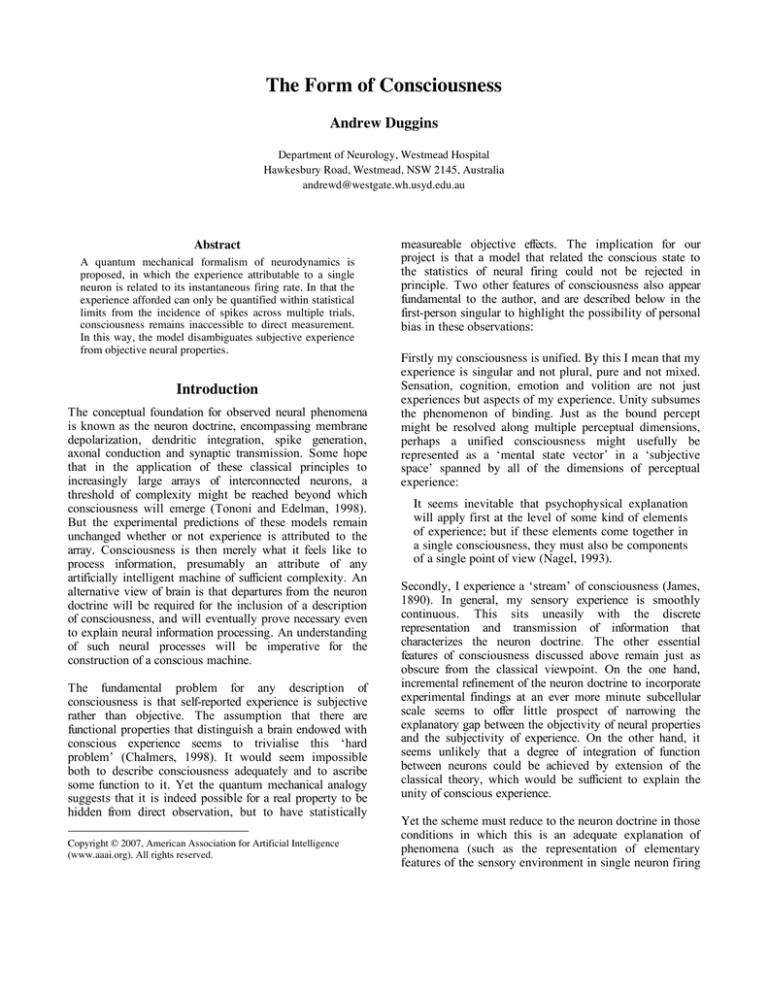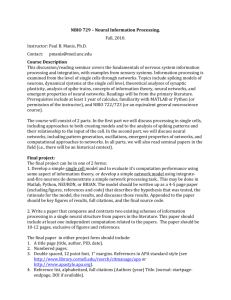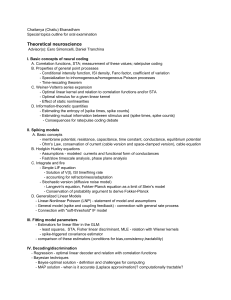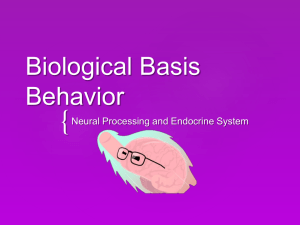
The Form of Consciousness
Andrew Duggins
Department of Neurology, Westmead Hospital
Hawkesbury Road, Westmead, NSW 2145, Australia
andrewd@westgate.wh.usyd.edu.au
Abstract
A quantum mechanical formalism of neurodynamics is
proposed, in which the experience attributable to a single
neuron is related to its instantaneous firing rate. In that the
experience afforded can only be quantified within statistical
limits from the incidence of spikes across multiple trials,
consciousness remains inaccessible to direct measurement.
In this way, the model disambiguates subjective experience
from objective neural properties.
Introduction
The conceptual foundation for observed neural phenomena
is known as the neuron doctrine, encompassing membrane
depolarization, dendritic integration, spike generation,
axonal conduction and synaptic transmission. Some hope
that in the application of these classical principles to
increasingly large arrays of interconnected neurons, a
threshold of complexity might be reached beyond which
consciousness will emerge (Tononi and Edelman, 1998).
But the experimental predictions of these models remain
unchanged whether or not experience is attributed to the
array. Consciousness is then merely what it feels like to
process information, presumably an attribute of any
artificially intelligent machine of sufficient complexity. An
alternative view of brain is that departures from the neuron
doctrine will be required for the inclusion of a description
of consciousness, and will eventually prove necessary even
to explain neural information processing. An understanding
of such neural processes will be imperative for the
construction of a conscious machine.
The fundamental problem for any description of
consciousness is that self-reported experience is subjective
rather than objective. The assumption that there are
functional properties that distinguish a brain endowed with
conscious experience seems to trivialise this ‘hard
problem’ (Chalmers, 1998). It would seem impossible
both to describe consciousness adequately and to ascribe
some function to it. Yet the quantum mechanical analogy
suggests that it is indeed possible for a real property to be
hidden from direct observation, but to have statistically
Copyright © 2007, American Association for Artificial Intelligence
(www.aaai.org). All rights reserved.
measureable objective effects. The implication for our
project is that a model that related the conscious state to
the statistics of neural firing could not be rejected in
principle. Two other features of consciousness also appear
fundamental to the author, and are described below in the
first-person singular to highlight the possibility of personal
bias in these observations:
Firstly my consciousness is unified. By this I mean that my
experience is singular and not plural, pure and not mixed.
Sensation, cognition, emotion and volition are not just
experiences but aspects of my experience. Unity subsumes
the phenomenon of binding. Just as the bound percept
might be resolved along multiple perceptual dimensions,
perhaps a unified consciousness might usefully be
represented as a ‘mental state vector’ in a ‘subjective
space’ spanned by all of the dimensions of perceptual
experience:
It seems inevitable that psychophysical explanation
will apply first at the level of some kind of elements
of experience; but if these elements come together in
a single consciousness, they must also be components
of a single point of view (Nagel, 1993).
Secondly, I experience a ‘stream’ of consciousness (James,
1890). In general, my sensory experience is smoothly
continuous. This sits uneasily with the discrete
representation and transmission of information that
characterizes the neuron doctrine. The other essential
features of consciousness discussed above remain just as
obscure from the classical viewpoint. On the one hand,
incremental refinement of the neuron doctrine to incorporate
experimental findings at an ever more minute subcellular
scale seems to offer little prospect of narrowing the
explanatory gap between the objectivity of neural properties
and the subjectivity of experience. On the other hand, it
seems unlikely that a degree of integration of function
between neurons could be achieved by extension of the
classical theory, which would be sufficient to explain the
unity of conscious experience.
Yet the scheme must reduce to the neuron doctrine in those
conditions in which this is an adequate explanation of
phenomena (such as the representation of elementary
features of the sensory environment in single neuron firing
rates (Britten et al., 1992)). Again 20th century physics
provides a template for this process. The assumptions that
we will inevitably require in developing this scheme might
be considered “bridging principles…basic elements to our
theory, not to be further explained” that “add the minimal
component” to the classical description to “bring
subjective experience in” (Chalmers, 1998). Ultimately, a
theory based on these axioms might be applied to the
correlation of firing between neurons, to produce results at
variance with the classical predictions.
Discussion
It is widely accepted that a neuron encodes information in
its firing rate. Typically, recording from a sensory neuron,
spike counts are averaged from corresponding bins in traces
evoked by multiple presentations of a stereotyped sensory
stimulus. Over an infinite ensemble of stimulus
repetitions, optimal bin size becomes infinitesimally short,
and the average count becomes an instantaneous firing rate
f(t).
Three related aspects of this conventional description of
neural firing warrant particular emphasis. Firstly, it is clear
that f(t) expresses that which is invariant in the neural
response across trials. However, f(t) has no objective
correlate on the single trial. We would be forced to concede
that no real-time neural representation of the sensory
environment exists, but for the fact that we each experience
a mental representation of the changing environment which
is continuous in time. Secondly, if we attribute to f(t) sole
significance in coding, we note the corollary that the
variability of spike timing across trials does not encode
any information about the sensory stimulus. Thirdly,
neural signaling is quantized: a spike either does or does
not occur at a moment in time. Moreover, the intensity of
the neural response is determined by the number of spikes
(per unit time), not the magnitude of the individual spike.
In quantum mechanics, it is only from the statistics of
discrete results of individual trials that an observer may
infer the quantum state. The state is a complete description
of the system, in the sense that outcomes are otherwise
truly random. These principles are needed to explain
observations on physical systems small enough, cold
enough or remote enough to be considered isolated from
their physical environment. Neurons fulfill none of these
criteria. However, the conceptual similarities suggest that
the mathematical framework of quantum mechanics might
provide a parallel formulation of neurodynamics.
Consider the slightly unrealistic situation in which a
single spike consistently occurs in response to the
presentation of a stereotyped sensory stimulus. In the
Copyright © 2007, American Association for Artificial Intelligence
(www.aaai.org). All rights reserved.
conventional description a spike is represented as a Dirac
(1958) delta function of time, δ (t – t1). Unlike δ(t – t1), the
probability density distribution p1 (t) is smooth and
continuous, reflecting the fact that an infinite number of
spikes of variable timing are included in the average. This
depiction of instantaneous firing rate as a normalized
probability distribution, implying as it does a single spike
‘waiting to happen’ in the period after each stimulus
presentation, might be considered a fictitious construct,
useful merely because it suggests a complementary
description of more realistic traces of multiple spikes,
leading to a more general description of the instantaneous
firing rate. On the other hand, we might conclude that the
actual existence of a ‘potential’, always created in response
to the sensory stimulus and eventually ‘annihilated’ as a
single spike, would be entirely consistent with the
conventional description of neural firing. We will refer to
this potential as the ‘action potential’ and the
depolarization event inevitably associated with it the
‘spike’ (in the conventional neuron doctrine, action
potential and spike are synonymous). The action potential
concept is useful because it suggests a general description
of the subjective correlate of the neural response on a single
trial, compatible with the instantaneous firing rate as a
description of the objective neural response over an infinite
ensemble of stimulus repetitions. Formulation of this
description will ultimately benefit from a system of
notation new to neuroscience (Dirac, 1958).
We will say that there is a ‘probability amplitude’ (or just
‘amplitude’) for one action potential to annihilate as a
spike within some time period t after presentation of the
sensory stimulus. This is a number symbolized
〈 spike will occur within time t | one action potential 〉
or in abbreviated form
〈 t1 ≤ t | 1 〉
We describe the inevitability of eventual action potential
annihilation as
〈 t1 ≤ ∞ | 1 〉 = 1
and the impossibility of spike without action potential
〈 t1 ≤ ∞ | 0 〉 = 0
suggesting a connection between amplitudes and
probabilities that we will develop below. We would also
assign zero amplitude to the simultaneous existence of
mutually exclusive one and zero action potential states:
〈1|0〉
= 〈0|1〉
= 0
This implies that | 0 〉 and | 1 〉 form an orthonormal basis
for a 2-dimensional vector space. Any vector | ψ 〉 within
this space is some linear combination of | 0 〉 and | 1 〉 :
|ψ〉= 〈0|ψ〉 |0〉 + 〈1|ψ〉 |1〉
We would like to equate each of these vectors to a neural
state of intermediate potential for spike generation, relative
to the 0- and 1-action potential states. We interpret 〈 1 | ψ
〉 as the probability amplitude of eventual spike occurrence,
but also as a scalar product: the component of | ψ 〉 on | 1
〉. For a normalized neural state, the sum of squared
magnitudes of amplitudes would equal 1. The probabilities
of a complete set of alternative outcomes must also sum to
1. We might then assume that in a complex vector space
description, |〈 1 | ψ 〉| 2 is the probability that one spike
will eventually occur, and that in general probabilities are
squared moduli of probability amplitudes.
These concepts can easily be generalized to traces of
multiple and variable numbers of spikes. For example, in
the state | ψ 〉, the expected number of spikes becomes:
state can no longer be equated with some objective
characteristic of the neuron that determines spike timing on
the individual trial (such as the excitatory post-synaptic
potential). Instead, the neural state as we define it remains
hidden from direct observation, only to be inferred from the
statistics of neural firing over a large ensemble of trials,
consistent with our intuitions about a descriptor of
subjective experience (see Introduction). On the other
hand, through observation of the neuron on a single trial, it
may be possible to acquire knowledge of spike probability
beyond that described by the state ψ. We must concede
that ψ does not provide a complete description of neural
firing on the individual trial. However, we will argue
below that it does provide a complete description of the
neural code for the invariant sensory stimulus across trials,
and of the subjective experience afforded by the neuron on a
single trial.
so that the expected spike count becomes:
Secondly, we must depart here from the conventional
interpretation of quantum mechanics. If instead we were to
invoke the quantum analogy, we would contend that by
the act of observing the neuron, the neuroscientist has
preserved the neuron in the 1-action potential state (not
unlike the quantum ‘Zeno effect’ (Misra, 1977)). This
unpalatable concept would then demand a theory of
‘measurement’ comparable to that of quantum mechanics,
with an inherent ‘measurement problem’ of defining what
constitutes an observation. However this is merely one
interpretation. The more general implication is that the
posterior probability of an eventual spike is reset by a
period o of null observation
〈n〉= 〈ψ|N|ψ〉
P( t1 > t + o | t1 > o ) = P( t1 > t )
Equivalently, we could describe the neural state ψ as an
operator | ψ 〉〈 ψ | which projects any vector in the neural
space onto | ψ 〉, so that:
This ‘memoryless’ property of the neural response defines
the relationship between the number of action potentials
and the instantaneous firing rate. Without new action
potential generation, 1 initial action potential declines
exponentially as
〈n〉
= 0 |〈 0 | ψ 〉|2 + 1 |〈 1 | ψ 〉|2 + 2 |〈 2 | ψ 〉|2 +…
= 0 〈ψ|0〉〈0|ψ〉 + 1 〈ψ|1〉〈1|ψ〉 + 2 〈ψ|2〉〈2|ψ〉 +…
= 〈 ψ | ( Σ n | n 〉〈 n | ) | ψ 〉
We will abbreviate the expression in brackets as the
‘number operator’
N
= Σ n | n 〉〈 n |
n
〈 n 〉 = tr( N | ψ 〉〈 ψ | )
Returning to the artificial model of the stereotyped sensory
stimulus that always elicits a single spike, we assume that
the stimulus always evokes the 1-action potential state at
time 0. However after time t the probability |〈 1 | ψ(t)〉|2
that one spike will be counted from t to ∞ will have
declined. It is important to note that this is an a priori
probability that does not take into account knowledge
gained by observing the neural response or lack of it before
time t. When a spike eventually does occur on a particular
trial, the posterior probability of another spike undergoes
an abrupt transition from 1 to 0, even as the a priori spike
potential declines continuously. While it is as if action
potentials annihilate as spikes, from now on we will take
the view that the neural state evolves continuously with
respect to a basis of integer action potential states.
|〈 1 | ψ(t)〉|2 = e-wt
This has several implications for the interpretation of the
current formalism. Firstly it is apparent that the neural
We have previously noted the correspondence between the
real-time mental representation of the sensory stimulus and
We differentiate the prior probability of spike timing t1 ≤ t
-wt
(= 1 - e ) to yield the probability density of spike timing
p1(t) = w e-wt
which also decays exponentially from an initial value of w.
We can extend these results to a neural space of higher
dimension if we assume that action potentials are identical
and do not interact. Then the instantaneous firing rate will
always be proportional to the expected number of action
potentials:
f(t)
= w 〈 n 〉 = w 〈 ψ0 | N | ψ0 〉 e-wt
the neural representation averaged over trials. We now
make this relationship between mind and brain explicit by
postulating that a ‘perception value’, a level of perceptual
experience afforded by a single neuron, is proportional to
the spike potential:
perception value (ψ) = r 〈 ψ | N | ψ 〉 = r tr( N | ψ 〉〈 ψ |
)
where r is a positive real number which remains constant
over time within a single neuron. A neuron in the ground
state of | 0 〉 will never spike and will afford a null percept.
The perception value associated with any other state will
be positive. The equally spaced levels of experience
corresponding to integer action potential states are the
eigenvalues of an operator
H = Σ r n | n 〉〈 n | = rN
n
which we will call the ‘nervous energy operator’. The
perception value 〈 ψ | H | ψ 〉 is also directly proportional
to the instantaneous firing rate
f(t)
experience in a simple case, but it is also possible to
describe how the neural state itself evolves in this process,
utilizing the quantum operations formalism of amplitude
damping. Moreover, this approach reveals how smooth
evolution of the mental state might arise from discrete
spikes and discontinuous synaptic interaction between
neurons.
References
Bell JS. On the Einstein Podolsky Rosen Paradox. Physics
1964; 1: 195-200.
Britten KH, Shadlen MN, Newsome WT, Movshon JA.
The analysis of visual motion: a comparison of neuronal
and psychophysical performance. J Neurosci 1992; 12:
4745-65.
Chalmers DJ. The problems of consciousness. Adv Neurol
1998; 77: 7-16; discussion 16-8.
= (w / r) 〈 ψ(t) | H | ψ(t)〉
In summary, we have taken some initial steps towards a
reconciliation of mind and brain at a single neuron level.
The central tenet of this new theory is that the component
of the inaccessible mental representation of the sensory
stimulus attributable to a single neuron becomes manifest
statistically as the instantaneous firing rate after infinite
stimulus repetition. It has been fruitful to adopt a quantum
mechanical formalism in which the state of the neuron is
represented as a vector in a complex vector space, or as a
projector from the space onto that vector. Extension of this
formalism to more realistic neural systems will merely
require the assimilation of the quantum mechanical
principles applicable in this broader context. For example,
using a tensor product formalism, state spaces of individual
neurons could be combined to form a composite neural
space, in which a pure ‘mental state’ would represent
unified conscious experience. The binding of elementary
features in this non-local mental state would be reflected in
specific patterns of correlated neural firing between remote
brain regions. In contrast, the conventional neuron doctrine
is classical and local realistic: whether or not a neuron fires
is determined solely by local factors such as the postsynaptic membrane potential and concentration of
electrolytes that obtain at that neuron at a moment in time.
These local factors would have no influence on whether a
remote neuron was simultaneously depolarised (the
influences on depolarisation of remote neurons would be
‘separable’). Local realistic constraints, expressed as Bell
Inequalities (Bell, 1964), limit potential correlations in
firing between remote neurons, presenting an opportunity
for experimental test of the scheme.
We have derived above a mathematical expression for the
smooth evolution of a single dimension of perceptual
Dirac PAM. The principles of quantum mechanics. Vol 27.
Oxford,: Oxford University Press, 1958.
James W. The principles of psychology. New York,: H.
Holt and company, 1890.
Misra BS, E. . The Zeno’s Paradox in Quantum Theory. J.
Math. Phys. 1977; 18: 756-763
Nagel T. What is the mind body problem? Vol 174.
Chichester ; New York: Wiley, 1993.
Tononi G, Edelman GM. Consciousness and complexity.
Science 1998; 282: 1846-51.






